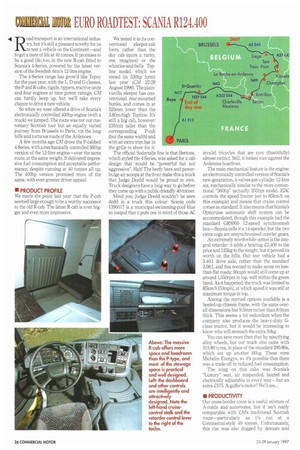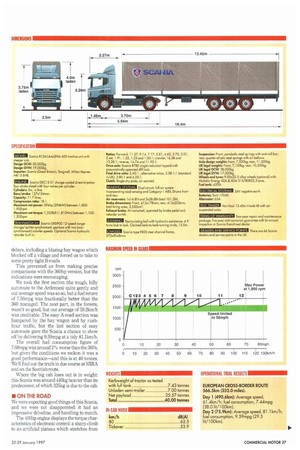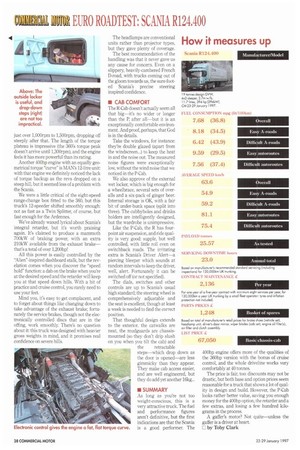4 oad transport is an international indus R
Page 28

Page 29

Page 30

If you've noticed an error in this article please click here to report it so we can fix it.
try, but it's still a pleasant novelty for us to test a vehicle on the Continent—and to get a taste of life at 40 tonnes. It promises to be a good life, too, in the new R-cab fitted to Scania's 4-Series, powered by the latest version of the Swedish firm's 12-litre engine.
The 4-Series range has grow'd like Topsy for the past year, with the L, D and G-classes, the P and R-cabs, rigids, tippers, tractive units and four engines at nine power ratings. CM can hardly keep up, but we'll take every chance to drive a new vehicle,
So when we were offered a drive of Scania's electronically controlled 400hp engine (with a truck) we jumped. The route was not our customary Scottish tour but an equally varied journey from Brussels to Paris, via the long hills and tortuous roads of the Ardennes.
A few months ago CM drove the P-cabbed 4-Series, with a mechanically controlled 360hp version of the 12-litre engine—over the same route, at the same weight. It delivered impressive fuel consumption and acceptable performance, despite running at 40 tonnes all up. The 400hp version promised more of the same, with even greater driver appeal.
• PRODUCT PROFILE
We made the point last year that the P-cab seemed large enough to be a worthy successor to the old R-cab. The latest R-cab is even bigger and even more impressive.
We tested it in its conventional sleeper-cab form, rather than the day cab (quite a rarity, one imagines) or the whistles-and-bells Topline model, which we tested (in 530hp form) last year (CM 22-28 August 1996). The plainvanilla sleeper has conventional rear-mounted bunks, and comes in at 525mm lower than the 3.80m-high Topline. It's still a big cab, however: 235mm taller than the corresponding P-cab (but the same width) and with an extra trim bar in the grille to show for it.
The official Sodertalje line is that Bertone, which styled the 4-Series, was asked for a cab design that would be "powerful but not aggressive". Hah! The beefy bars and powerbulge air scoops at the front make this a truck that Judge Dredd would be proud to own. Truck designers have a long way to go before they come up with a public-friendly 40-tormer.
Mind you, Judge Dredd wouldn't be seen dedd in a truck this colour: Scania code 1396017 is a municipal-swimming-pool blue so insipid that it puts one in mind of those AC invalid tricycles that are now (thankfully) almost extinct. Still, it looked nice against the Ardennes hoarfrost.
The main mechanical feature is the engine: an electronically controlled version of Scania's new-generation, 4-valves-per-cylinder 12-litre six, mechanically similar to the more conventional "360hp" (actually 355hp) model. EDC controls the speed limiter (set to 85km/h on this example) and means that cruise control comes as standard. It also means that Scania's Opticruise automatic shift system can be accommodated, though this example had the standard GRS900 12-speed synchromesh box—Scania calls it a 14-speeder, but the two extra cogs are unsynchronised crawler gears.
An extremely worthwhile option is the integral retarder: it adds a bracing 0,400 to the price and 125kg to the weight, but it proved its worth on the hills. Our test vehicle had a 3.40:1 drive axle, rather than the standard 3.08:1, and this seemed to make sense on lessthan-flat roads: 56mph would still come up at around 1,550rpm in top, well within the green band. As it happened, the truck was limited to 85km/h (53mph), at which speed it was still at maximum torque in top.
Among the myriad options available is a beefed-up chassis frame, with the same overall dimensions but 9.5mm rather than 8.0mm thick. This seems a bit redundant when the company also produces the heavy-duty Gclass tractor, but it would be interesting to know who will stomach the extra 50kg.
You can save more than that by specifying alloy wheels, but our truck also came with 315/80 tyres, in place of the standard 295/80s, which eat up another 60kg. These were Michelin Energys, so it's possible that there was a trade-off in reduced fuel consumption.
The icing on this cake was Scania's "Luxury" seat, air suspended, heated and electrically adjustable in every way—but an extra £575. A gaffer's motor? We'll see...
• PRODUCTIVITY
Our cross-border route is a useful mixture of A-roads and autoroutes, but it isn't really comparable with CM's traditional Scottish route—particularly as it's run at a Continental-style 40 tonnes. Unfortunately, this run was also dogged by detours and delays, including a blazing hay wagon which blocked off a village and forced us to take to some pretty tight B-roads.
This prevented us from making precise comparisons with the 360hp version, but the indications were encouraging.
We took the first section (the tough, hilly autoroute to the Ardennes) quite gently and our average speed was so-so, but a fuel return of 7.56mpg was fractionally better than the 360 managed. The next part, in the forests, wasn't so good, but our average of 59.2kmfh was creditable. The easy A-road section was hampered by the hay wagon and by rushhour traffic, but the last section of easy autoroute gave the Scania a chance to show off by delivering 9.59mpg at a tidy 81.1km/h.
The overall fuel consumption figure of 7.68mpg was around 2% worse than the 360's, but given the conditions we reckon it was a good performance-and this is at 40 tonnes. We'll find out the truth in due course at MIRA and on the Scottish route.
Where the big cab loses out is in weight: this Scania was around 440kg heavier than its predecessor, of which 325kg is due to the cab.
• ON THE ROAD
We were expecting good things of this Scania, and we were not disappointed: it had an impressive driveline, and handling to match.
The 400hp engine displays the torque characteristics of electronic control: a sharp climb to an artificial plateau which stretches from just over 1,000rpm to 1,500rpm, dropping off steeply after that. The length of the torque plateau is impressive (the 360's torque peak doesn't arrive until 1,300rpm), and the engine feels it has more powerful than its rating.
Another 400hp engine with an equally geometrical torque "curve" is IVIAN's 12-litre unit: with that engine we definitely noticed the lack of torque backup as the revs dropped on a steep hill, but it seemed less of a problem with the Scania.
We were a little critical of the eight-speed range-change box fitted to the 360, but this truck's 12-speeder shifted smoothly enough: not as fast as a Twin Splitter, of course, but fast enough for the Ardennes.
We've already waxed lyrical about Scania's integral retarder, but it's worth praising again. It's claimed to produce a mammoth 700k)71/ of braking power, with an extra 210kW available from the exhaust brake— that's a total of over 1,200hp!
All this power is easily controlled by the "Alien"-inspired dashboard stalk, but the revelation comes when you discover the "speed hold" function: a dab on the brake when you're at the desired speed and the retarder will keep you at that speed down hills. With a bit of practice and cruise control, you rarely need to use your feet.
Mind you, it's easy to get complacent, and to forget about things like changing down to take advantage of the exhaust brake; fortunately the service brakes, though not the electronically controlled discs that are in the offing, work smoothly. There's no question about it: this truck was designed with heavier gross weights in mind, and it promises real confidence on severe hills. The headlamps are conventional units rather than projector types, but they gave plenty of coverage.
The best recommendation of the handling was that it never gave us any cause for concern. Even on a slippery, heavily-cambered French D-road, with trucks coming out of the gloom towards us, the sure-footed Scania's precise steering inspired confidence.
• CAB COMFORT The R-Cab doesn't actually seem all that big—ifs no wider or longer than the P, after all—but it is an exceptionally comfortable environment, And proof, perhaps, that God is in the details.
Take the windows, for instance: they're double glazed (apart from the windscreen...) to keep the heat in and the noise out. The measured noise figures were exceptionally low, without the wind noise that we noticed in the P-Cab.
We also approve of the external wet locker, which is big enough for a wheelbrace, several sets of overalls and a six-pack of ginger beer. Internal storage is OK, with a fair bit of under-bunk space (split into three). The cubbyholes and drinks holders are intelligently designed, but the wardrobe is unimpressive.
Like the P-Cab, the R has fourpoint air suspension, and ride quality is very good: supple, but well controlled, with little roll even on switchback roads. The irritating extra is Scania's Driver Alert--a piercing bleeper which sounds at random intervals to keep the driver, well, alert. Fortunately it can be switched off (or not specified).
The dials, switches and other controls are up to Scania's usual high standard; the steering wheel is comprehensively adjustable and the seat is excellent, though at least a week is needed to find the correct position.
That thoughful design extends to the exterior, the catwalks are neat, the mudguards are chassismounted (so they don't drip slush on you when you tilt the cab) and the retractable steps—which drop down as the door is opened—are less gimmicky than they appear. They make cab access easier, and are well engineered, but they do add yet another 16kg...
• SUMMARY
As long as you're not too weight-conscious, this is a very attractive truck, The fuel and performance figures aren't definitive, but the first indications are that the Scania is a good performer. The 400hp engine offers more of the qualities of the 360hp version with the bonus of cruise control, and the whole driveline works very comfortably at 40 tonnes.
The price is fair, too: discounts may not be drastic, but both base and option prices seem reasonable for a truck that shows a lot of quality in design and build. However, the P-Cab looks rather better value, saving you enough money for the 400hp option, the retarder and a few extras, and losing a few hundred kilograms in the process.
A gaffer's motor? Not quite—unless the gaffer is a driver at heart
D by Toby Clark
































































































